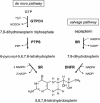Novel strategies to ameliorate radiation injury: a possible role for tetrahydrobiopterin
- PMID: 20583982
- PMCID: PMC3311028
- DOI: 10.2174/1389450111009011366
Novel strategies to ameliorate radiation injury: a possible role for tetrahydrobiopterin
Abstract
Novel pharmacological strategies are urgently needed to prevent or reduce radiation-induced tissue injury. Microvascular injury is a prominent feature of both early and delayed radiation injury. Radiation-induced endothelial dysfunction is believed to play a key role in the pathogenesis of post-irradiation tissue injury. Hence, strategies that could prevent or improve endothelial malfunction are expected to ameliorate the severity of radiation injury. This review focuses on the therapeutic potential of the nitric oxide synthase (NOS) cofactor 5,6,7,8-tetrahydrobiopterin (BH4) as an agent to reduce radiation toxicity. BH4 is an essential cofactor for all NOS enzymes and a critical determinant of NOS function. Inadequate availability of BH4 leads to uncoupling of the NOS enzyme. In an uncoupled state, NOS produces the highly oxidative radicals superoxide and peroxynitrite at the cost of NO. Under conditions of oxidative stress, such as after radiation exposure, BH4 availability might be reduced due to the rapid oxidation of BH4 to 7,8-dihydrobiopterin (7,8-BH2). As a result, free radical-induced BH4 insufficiency may increase the oxidative burden and hamper NO-dependent endothelial function. Given the growing evidence that BH4 depletion and subsequent endothelial NOS uncoupling play a major role in the pathogenesis of endothelial dysfunction in various diseases, there is substantial reason to believe that improving post-irradiation BH4 availability, by either supplementation with it or modulation of its metabolism, might be a novel strategy to reduce radiation-induced endothelial dysfunction and subsequent tissue injury.
Figures



Similar articles
-
Recoupling the cardiac nitric oxide synthases: tetrahydrobiopterin synthesis and recycling.Curr Heart Fail Rep. 2012 Sep;9(3):200-10. doi: 10.1007/s11897-012-0097-5. Curr Heart Fail Rep. 2012. PMID: 22711313 Free PMC article. Review.
-
Synthesis and recycling of tetrahydrobiopterin in endothelial function and vascular disease.Nitric Oxide. 2011 Aug 1;25(2):81-8. doi: 10.1016/j.niox.2011.04.004. Epub 2011 Apr 22. Nitric Oxide. 2011. PMID: 21550412 Free PMC article. Review.
-
Cell type-specific recycling of tetrahydrobiopterin by dihydrofolate reductase explains differential effects of 7,8-dihydrobiopterin on endothelial nitric oxide synthase uncoupling.Biochem Pharmacol. 2014 Aug 1;90(3):246-53. doi: 10.1016/j.bcp.2014.05.010. Epub 2014 May 24. Biochem Pharmacol. 2014. PMID: 24863258 Free PMC article.
-
Reduction of radiation-induced vascular nitrosative stress by the vitamin E analog γ-tocotrienol: evidence of a role for tetrahydrobiopterin.Int J Radiat Oncol Biol Phys. 2011 Mar 1;79(3):884-91. doi: 10.1016/j.ijrobp.2010.08.032. Epub 2010 Oct 13. Int J Radiat Oncol Biol Phys. 2011. PMID: 20950957 Free PMC article.
-
The role of tetrahydrobiopterin in inflammation and cardiovascular disease.Thromb Haemost. 2012 Nov;108(5):832-9. doi: 10.1160/TH12-06-0424. Epub 2012 Oct 10. Thromb Haemost. 2012. PMID: 23052970 Free PMC article. Review.
Cited by
-
Emerging pharmacotherapy for cancer patients with cognitive dysfunction.BMC Neurol. 2013 Oct 24;13:153. doi: 10.1186/1471-2377-13-153. BMC Neurol. 2013. PMID: 24156319 Free PMC article. Review.
-
Pentoxifylline enhances the radioprotective properties of γ-tocotrienol: differential effects on the hematopoietic, gastrointestinal and vascular systems.Radiat Res. 2011 Mar;175(3):297-306. doi: 10.1667/RR2399.1. Epub 2010 Dec 28. Radiat Res. 2011. PMID: 21388273 Free PMC article.
-
Antioxidant Supplementation: A Linchpin in Radiation-Induced Enteritis.Technol Cancer Res Treat. 2017 Dec;16(6):676-691. doi: 10.1177/1533034617707598. Epub 2017 May 22. Technol Cancer Res Treat. 2017. PMID: 28532242 Free PMC article.
-
Sex Differences in Urinary Metabolite Profiles between Survivors and Non-Survivors of Radiation-induced Lung Injury in the C57L/J Murine Model.Radiat Res. 2025 Jul 1;204(1):1-14. doi: 10.1667/RADE-25-00066.1. Radiat Res. 2025. PMID: 40383530
-
Amelioration of radiation-induced skin injury by tetrahydrobiopterin: preclinical study and phase II trial.Mol Biomed. 2025 Jan 26;6(1):5. doi: 10.1186/s43556-025-00246-x. Mol Biomed. 2025. PMID: 39863808 Free PMC article. No abstract available.
References
-
- Weiss JF, Landauer MR. Radioprotection by antioxidants. Ann NY Acad Sci. 2000;899:44–60. - PubMed
-
- Hosseinimehr SJ. Trends in the development of radioprotective agents. Drug Discov Today. 2007;12:794–805. - PubMed
-
- Koukourakis MI, Kyrias G, Kakolyris S, et al. Subcutaneous administration of amifostine during fractionated radiotherapy: a randomized phase II study. J Clin Oncol. 2000;18:2226–33. - PubMed
-
- Paris F, Fuks Z, Kang A, et al. Endothelial apoptosis as the primary lesion initiating intestinal radiation damage in mice. Science. 2001;293:293–7. - PubMed
Publication types
MeSH terms
Substances
Grants and funding
LinkOut - more resources
Full Text Sources
Other Literature Sources
Research Materials
